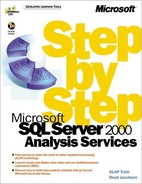Start the Lesson
1. | Start Analysis Manager. Right-click the server, and click Restore Database. |
2. | Navigate to the folder containing the sample files for this book, select Chapter 6, and click Open. Click Restore, and then close the Restore Database Progress dialog box. The archived Chapter 6 OLAP database contains a Sales cube identical to the one you created in Chapter 3, “Dimension and Cube Editors,” but without calculated and derived measures. |
A spreadsheet is an effective tool for analyzing numbers, allowing you to create extremely flexible formulas. A spreadsheet gets very cumbersome, however, when you’re dealing with large masses of data or when you need to organize the values differently.
A database is an effective tool for storing and retrieving numbers, allowing you to use the same values in multiple reports or views. A database gets very frustrating, however, when you need to create complex formulas—particularly formulas that need to know about the relationships between different members of a dimension.
Imagine a database that allows you to store and retrieve massive quantities of data, with whatever degree of flexibility you want, but that also allows you to create formulas as complex and sophisticated as those in any spreadsheet. Imagine a spreadsheet with formulas and functions specifically designed for business analysis but that also automatically fills formulas into the necessary ranges. In this chapter, you’ll learn about MDX—a tool that enables you to turn a large OLAP database into a sophisticated calculation engine.
